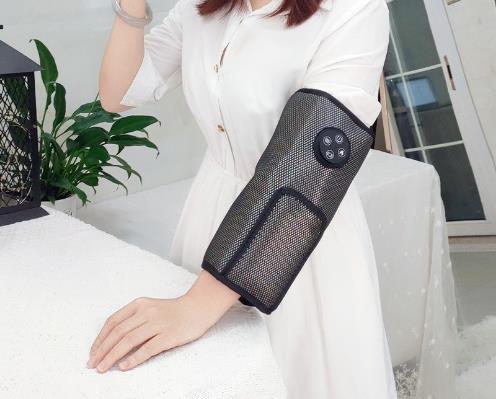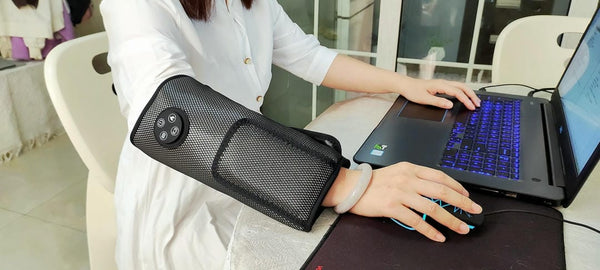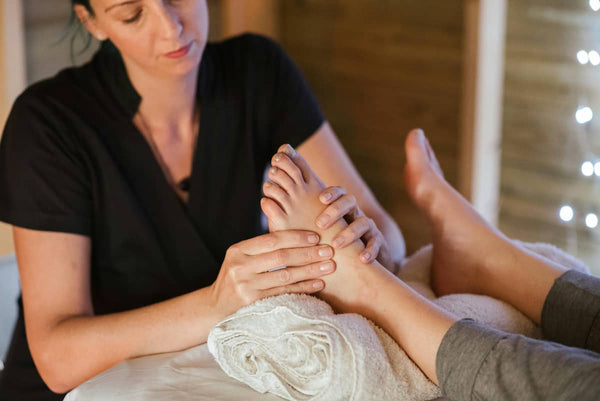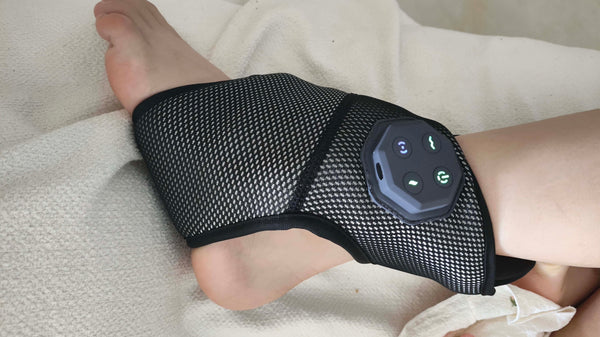 For many middle-aged and elderly individuals, cycling offers a fantastic way to stay active, enjoy the outdoors, and maintain cardiovascular health. It's often recommended as a low-impact exercise, which is generally true and a significant benefit. However, even with its advantages, knee discomfort can sometimes creep in, turning a pleasant ride into a painful chore. The big question then becomes: how do we protect our knees and keep cycling enjoyable for the long haul? This often brings us to consider aids like knee braces or the increasingly popular smart knee massager. As an evaluator of health products, I've seen many people ponder this.
For many middle-aged and elderly individuals, cycling offers a fantastic way to stay active, enjoy the outdoors, and maintain cardiovascular health. It's often recommended as a low-impact exercise, which is generally true and a significant benefit. However, even with its advantages, knee discomfort can sometimes creep in, turning a pleasant ride into a painful chore. The big question then becomes: how do we protect our knees and keep cycling enjoyable for the long haul? This often brings us to consider aids like knee braces or the increasingly popular smart knee massager. As an evaluator of health products, I've seen many people ponder this.
The goal here isn't to declare one a universal "winner" over the other. Instead, let's approach this rationally, exploring what each option offers, how they work, and in what situations they might be most beneficial, especially for those of us whose joints have a bit more mileage on them. We'll touch upon suggestions for knee joint protection, whether you're enjoying a gentle park path or tackling more challenging (perhaps even light mountain biking) terrains, and look at various knee pain relief products.
The Cyclist's Knee: Stresses from Gentle Rides to Trails
Your knee is a complex marvel of engineering, a hinge joint that also allows for some rotation. When you cycle, it goes through thousands of flexion and extension cycles. On smooth, flat terrain with a properly fitted bike, this motion is generally fluid and well-tolerated. This is why cycling is often a go-to for maintaining mobility and strength as we age. However, factors like improper bike fit, poor pedaling technique, muscle imbalances, or pre-existing conditions like osteoarthritis can introduce problematic stresses. Even a slight saddle height miscalculation can change knee angles enough to cause strain over time.
Now, if we consider more demanding cycling, such as mountain biking – a focus of some debate on knee protection – the stresses multiply. Uneven terrain, steep climbs requiring more force, and descents that involve absorbing impacts can significantly load the knee joint. While exhilarating, this type of riding demands more from the knees. For middle-aged and elderly individuals, even if not engaging in extreme mountain biking, understanding these potential stresses helps in choosing appropriate safeguards, whether it's a supportive knee compression brace or a recovery tool like a smart knee massager. The aim is to prevent minor niggles from becoming persistent problems.
- Repetitive motion: Thousands of pedal strokes per ride.
- Force transmission: Powering the bike through the knee joint.
- Potential for malalignment: Due to bike fit or muscle weakness.
- Increased impact/load: Especially in more varied or challenging terrains like light trails.
Behind the Support: How Braces and Smart Knee Massagers Work
Let's demystify these devices with a touch of science. Knee braces primarily offer mechanical support. Simpler ones, like a knee compression brace, provide gentle pressure that can improve proprioception (your sense of joint position) and help manage minor swelling. More structured braces, sometimes considered if one is looking for the best knee brace for arthritic knee pain during activity, might include stays or hinges to offer more stability, guide movement, or offload pressure from a specific part of the knee. Their function is largely about support and protection *during* activity.
A smart knee massager, on the other hand, operates on different principles, mostly focused on recovery and relief *after* (or sometimes before) activity. These devices typically combine several therapeutic modalities. Heat therapy, for instance, helps to increase blood flow to the area, which can relax muscles and ease stiffness – a common complaint for many. Vibration massage can stimulate muscles and further enhance circulation. Air compression, a feature in many advanced models, provides a rhythmic squeezing action that can help reduce swelling and soothe tired tissues. Some even incorporate red light therapy, which some research suggests may aid in reducing inflammation and promoting tissue repair. The user who believes massagers are mostly for muscle relaxation after exercise (Perspective 3) is certainly on the right track, as this is a primary benefit of a smart knee massager.
- Knee Braces: Provide external stability, compression for proprioception/swelling, offload specific joint compartments, limit potentially harmful movements.
- Smart Knee Massagers: Employ heat for vasodilation and muscle relaxation, vibration for increased circulation and sensory pain relief, air compression for lymphatic drainage and reducing muscle soreness.
Choosing Wisely: Types & Applications for Cycling Knee Care
When selecting a knee support for cycling, especially for the middle-aged and elderly, it's crucial to avoid common pitfalls. Not every ache needs a heavy-duty brace. For general support or mild instability, a flexible neoprene sleeve or a knee compression brace might be perfectly adequate. These offer warmth and proprioceptive feedback without overly restricting movement – addressing the debate on flexibility versus protection (Perspective 2). If osteoarthritis is a concern, your doctor might suggest a specific type of offloader brace, but this is a medical decision. Heavy, restrictive braces, unless specifically prescribed, can sometimes do more harm than good by altering natural biomechanics or weakening supporting muscles over time.
For a smart knee massager, the choices are also varied. When reading knee massager reviews, pay attention to features relevant to your needs. Adjustable heat settings are vital – too hot is uncomfortable, too cool ineffective. Multiple massage modes and intensity levels allow customization. For ease of use, look for clear controls and a comfortable fit. Portability might be a factor if you travel. These devices are excellent for post-ride recovery, easing general stiffness, or as a comforting ritual for chronically achy knees. This aligns with Perspective 1, recommending massagers with relief functions. The best knee massager for arthritis often includes gentle heat and compression, which can be very soothing.
-
Brace Types for Consideration:
- Compression sleeves: For warmth, mild support, proprioception.
- Wraparound braces: Adjustable compression, easier to put on.
- Patellar straps/braces: For specific kneecap issues (consult a professional).
- Avoid overly rigid braces unless medically advised.
-
Smart Knee Massager Features to Evaluate:
- Adjustable heat levels.
- Multiple massage modes (e.g., vibration, air compression).
- Adjustable intensity.
- Ease of use and comfortable fit.
- Battery life and portability if needed.
Safe and Effective Use: Practical Tips for Joint Wellness
Using these aids effectively means using them safely. If you opt for a knee brace, ensure it fits correctly – not too tight to restrict circulation, and not too loose to be ineffective. It's generally best used for activities that you know might aggravate your knee, rather than all day, every day, unless advised by a healthcare professional. Listen to your body; if a brace causes discomfort or new pain, it’s not the right fit or type for you. Remember, a brace is an aid, not a cure, and shouldn't replace strengthening exercises for the muscles that support your knee.
With a smart knee massager, start with lower intensity and heat settings to see how your body responds, especially if you have sensitive skin or circulatory issues. A typical session might last 15-20 minutes. These are wonderful for winding down after a ride or easing morning stiffness. Crucially, neither a brace nor a massager should be a substitute for addressing the root cause of knee pain. Ensure your bike fit is professionally checked – this is often the single most important factor in preventing cycling-related knee issues. Gentle warm-ups before riding and cool-downs with stretching afterwards are also vital components of knee care. These are key knee pain relief products and practices when used correctly.
- Brace Safety: Ensure proper fit, use for specific activities, don't ignore pain.
- Smart Knee Massager Safety: Start with low settings, limit session duration (e.g., 15-30 mins), avoid use on acute injuries or open wounds without medical advice.
- Holistic Approach: Prioritize correct bike fit, regular gentle stretching, and appropriate muscle strengthening.
 Beyond Devices: Holistic Knee Health and When to See a Doctor
Beyond Devices: Holistic Knee Health and When to See a Doctor
While knee braces and a smart knee massager can be valuable tools, they are part of a broader picture of knee health. Maintaining a healthy weight reduces overall stress on your knee joints. A balanced diet rich in anti-inflammatory foods can also contribute to joint comfort. Hydration is important too, as cartilage health depends on it. Consider other gentle, joint-friendly activities like swimming or walking to complement your cycling and keep your muscles strong and flexible without overstressing the knees. Many find these holistic approaches to be effective long-term knee pain relief products in their own right.
It's very important to know when to seek professional help. If you experience sudden, sharp knee pain, significant swelling, an inability to bear weight, or pain that persists or worsens despite home care, it's time to consult your doctor or a physiotherapist. Self-diagnosing and self-treating serious issues can lead to bigger problems down the line. A professional can help identify the cause of your pain and recommend the most appropriate treatment plan, which might include specific exercises, medication, or advice on the best type of support for your individual situation, perhaps even guiding you to the best knee brace for arthritic knee if that's the underlying issue.
- Lifestyle factors: Healthy weight, anti-inflammatory diet, hydration.
- Complementary exercises: Gentle stretching, strengthening, other low-impact activities.
- Red flags for professional consultation: Persistent or worsening pain, significant swelling, instability, inability to bear weight, mechanical symptoms (locking/catching).
In the end, deciding between a knee brace and a smart knee massager for cycling isn't about an "either/or" choice for most middle-aged and elderly individuals. They serve different, often complementary, roles. A brace can offer valuable support and stability *during* your ride, especially if you have known vulnerabilities or are venturing onto slightly more challenging paths. A smart knee massager, however, shines as a tool for recovery, comfort, and managing the day-to-day stiffness or aches that can accompany an active lifestyle as we age. It's a proactive way to care for your joints.
My advice, as someone who evaluates these products, is to consider your specific needs and activity levels. A well-chosen, good-quality smart knee massager can be a truly wonderful addition to your wellness toolkit, helping to keep your knees feeling good so you can continue to enjoy the many benefits of cycling. Always combine these aids with smart practices like proper bike fit and listening to your body. Avoiding pitfalls means making informed choices, and I hope this overview helps you do just that. Don't forget to check out knee massager reviews to find a device that suits you best.
FAQ: Your Knee Care Questions Answered
Do knee massagers work for chronic pain?
For many individuals, a smart knee massager can be a helpful component in managing chronic knee pain, such as that from osteoarthritis or long-term overuse. They often work by increasing blood flow, relaxing tight muscles, and providing soothing warmth, which can temporarily reduce pain perception and improve comfort. While they are not a cure for chronic conditions, they can offer symptomatic relief and improve quality of life. Consistent use might help manage stiffness and soreness. However, it's always best to consult with a healthcare professional to diagnose the cause of chronic pain and develop a comprehensive treatment plan, of which a smart knee massager could be one part. They are popular knee pain relief products for this type of ongoing management.
How to massage fluid out of knee?
If you have noticeable fluid accumulation or swelling (effusion) in your knee, it's really, really important to see a doctor first to determine the cause, as it could indicate an underlying injury or medical condition that needs specific treatment. Attempting to aggressively "massage fluid out" on your own without professional guidance can be risky and potentially worsen the situation. Gentle lymphatic drainage massage techniques, performed by a trained therapist, are sometimes recommended by doctors as part of a treatment plan. For very mild puffiness not related to an acute injury, some people find that gentle, upward stroking massage (towards the body's core), combined with elevation, rest, and possibly cold therapy, can be helpful. A smart knee massager with gentle compression might aid overall circulation but is not designed as a primary tool to manually expel significant joint fluid due to an injury.
Are smart knee massagers like KLCOSY effective with red light features?
Some smart knee massagers on the market, potentially including specific brands like KLCOSY if they advertise this feature, do incorporate red light therapy. Red light therapy is a non-invasive treatment that uses specific wavelengths of red and near-infrared light. The theory is that these light waves can penetrate the skin to stimulate cellular processes, potentially reducing inflammation, promoting tissue repair, and improving circulation. While research is ongoing, some studies and many anecdotal user reports suggest benefits for pain relief and healing. The effectiveness can depend on the specific wavelength, power density, and duration of use. When looking at a smart knee massager with red light, it's one more feature that could contribute to its overall therapeutic effect, but it's wise to look at comprehensive knee massager reviews and consider it as one part of the device's potential benefits rather than a standalone miracle cure. As of my last update, specific clinical trial data on every brand is not always widely available, so user experience and general research on red light therapy are key considerations.
This reply is generated based on currently verifiable public information. It is recommended to cross-check key content with authoritative sources. The information provided in this article is for general informational purposes only and does not constitute medical advice. Always seek the advice of your physician or other qualified health provider with any questions you may have regarding a medical condition.




0 comments